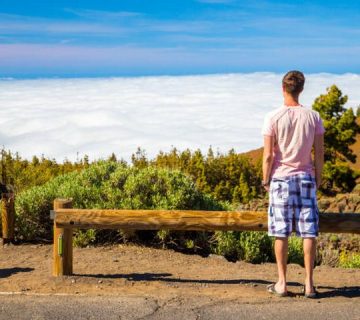How To Make The Most Of A Solo Kilimanjaro Summit Night
Unlock the Secrets of a Solo Summit under the Stars
Standing alone amidst the sprawling silence of Kilimanjaro’s majestic peak, under a blanket of twinkling stars, is an experience that calls to the wild spirit in all of us. For the adventurous souls who dare to face the mountain solo, the night before the summit unfolds like a profound personal journey. It’s not just about conquering Africa’s highest peak — it’s about conquering yourself.
In this blog post, we, at Kilimanjaro Centre for Trekking and Ecotourism (KCTE), will guide you through the enchanting experience of a solo Kilimanjaro summit night. We’ll provide you with expert tips on how to maximize this life-changing adventure, ensuring it’s not only safe but also deeply rewarding. So, lace up your boots, and let’s embark on an unforgettable journey to the roof of Africa!
Preparing for Your Solo Summit Night
Train Smart
Preparation is key when tackling Kilimanjaro solo. Start by conditioning your body months in advance with cardiovascular exercises, strength training, and plenty of hiking. Familiarize yourself with night trekking, as the summit push typically starts around midnight.
Pack Wisely
For a successful summit night, you need the right gear. Insulated clothing, a sturdy pair of boots, a warm sleeping bag, a reliable headlamp, and enough water and snacks are essential. Don’t forget your camera to capture the sunrise from the summit!
Know Your Route
Studying the route beforehand is crucial. Understand the terrain and approximate timings. Most climbers choose the Marangu or Machame routes for solo treks as they are well-trodden and marked.
Embracing the Solo Journey
Connect With Nature
One of the most profound parts of a solo climb is the deep connection to nature. As you ascend in solitude, pay attention to the whispering winds, the rugged texture of the rocks, and the vast sky above. This harmonious environment offers a perfect setting for introspection.
Manage Your Pace and Energy
Maintain a steady, manageable pace. ‘Pole pole’ (slowly, slowly in Swahili) is the mantra on Kilimanjaro. This approach not only helps in altitude acclimatization but also conserves energy for the demanding final hours of your ascent.
Stay Hydrated and Nourished
Keep sipping water throughout your climb. Dehydration is a common issue that can lead to altitude sickness. Nutritious snacks like nuts, chocolate, and dried fruits can provide quick energy during your ascent.
The Summit Night: A Spiritual Experience
Start with a Positive Mindset
Begin your summit night with a mindset focused on success and self-belief. Remember, this journey is as much mental as it is physical.
Experience the Stars
The night sky at high altitude is a spectacle of its own. Allow yourself some moments to soak in the cosmic display — it’s like a natural encouragement as you push towards the summit.
Capture the Sunrise
Reaching the summit in time to witness the first rays of the sun lighting up the vast African landscape is truly magical. Position yourself for the best view, and let this unforgettable sight be the reward for your perseverance.
Safety and Etiquette
Respect the Mountain
Mount Kilimanjaro is not only a natural wonder but also a sacred site for the local Chagga people. Treat the trails and surroundings with respect, keeping noise to a minimum and carrying out all your trash.
Know When to Turn Back
Understanding your physical limits is crucial. If you feel overly fatigued or show symptoms of altitude sickness, it’s wise to descend. Remember, the mountain will always be there for another attempt.
After the Descent: Reflect and Celebrate
Once you’ve descended and rested, take time to reflect on your journey. Every climber’s experience is unique and offers valuable insights into personal strength and resilience. Celebrate your achievement, no matter how far you reached — climbing Kilimanjaro is a commendable feat!
Why Climb with Kilimanjaro Centre for Trekking and Ecotourism (KCTE)?
Choosing to climb with KCTE means you’re setting yourself up for success. We provide expert guides, comprehensive pre-climb training, and round-the-clock support. Our tailored solo climber packages ensure you have the freedom yet the guidance necessary for a safe and enriching experience.
FAQs: Your Top Questions Answered
Is it safe to climb Kilimanjaro solo?
Yes, it is safe as long as you are well-prepared, follow the guidance provided by experienced operators like KCTE, and adhere to safety protocols.
What is the best time of year to attempt a solo summit?
The best times are during the dry seasons, from June to October and from December to March, when the weather is most favorable.
How long does it take to summit and descend?
It typically takes 5-7 days depending on the route and pace. We recommend taking enough time to acclimatize properly.
Can I join a group if I change my mind about going solo?
Absolutely! KCTE offers the flexibility to merge with a group if you decide you’d prefer company.
Embrace the Challenge with KCTE
As you contemplate the silent, starry trek to the top of Kilimanjaro, remember that your journey with KCTE is one paved with support, expertise, and a profound respect for both the mountain and the climber. Ready to make the most of your solo Kilimanjaro summit night? Contact us today and let’s start planning your adventure. Because at KCTE, we believe the journey should be just as memorable as the destination.




